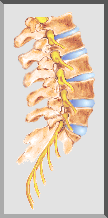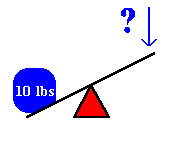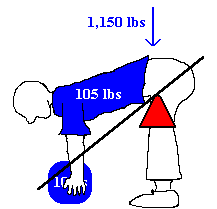Anatomy
of the Back: Why Do Injuries Occur?
In
order to understand why back injuries are so common, you have to
understand a little bit about the anatomy of the back and the physical
forces that may come into play.
The
Spine
The
human spine
(or backbone) is made up of small bones called vertebrae.
 |
|
The
Spine: Courtesy of
the Medical Multimedia Group
|
The
vertebrae are stacked on top of each other to form a column. Between
each vertebra is a cushion known as a disc. The vertebrae are held
together by ligaments, and muscles are attached to the vertebrae by
bands of tissue called tendons.
Openings
in each vertebra line up to form a long hollow canal. The spinal cord
runs through this canal from the base of the brain. Nerves from the
spinal cord branch out and leave the spine through the spaces between
the vertebrae. This cross-section
of the spine shows how the spinal nerves and spinal cord are
protected.
The
lower part of the back holds most of the body's weight. Even a minor
problem with the bones, muscles, ligaments, or tendons in this area
can cause pain when a person stands, bends, or moves around. Less
often, a problem with a disc can pinch or irritate a nerve from the
spinal cord, causing pain that runs down the leg below the knee,
called sciatica. Every time you bend or move, these disks compress
(.avi animation 642K) with the motion of the spine.
Types
of Injuries
Every
time you bend over, lift a heavy object, or sit leaning forward, you
put stress on the components of your back and spine. Over time, they
can start to wear out and become damaged.
Many
of the problems that cause back pain are the result of injury and
degeneration of the intervertebral disk. Degeneration is a process
where wear and tear causes deterioration, like when your favorite
jeans get old. The disk is subjected to different types of stress as
we use our backs each day.
Eventually,
disks can collapse or herniate (.avi
animation 277K); vertebrae can shift; bone spurs can develop.
Acute
or immediate injuries to the back can be caused by tearing or
straining ligaments and muscles. Muscles can also spasm due to stress
or tension.
The
Forces Involved
The
amount of force placed on your back under certain conditions can be
surprising. Anytime you bend or lean over to pick something up, you
put tremendous pressure on your lower back.
 |
To
demonstrate this, think of your back as a lever. With the
fulcrum in the center of the lever, how many pounds
would it take to lift a ten pound object?
A.
5 pounds
B.
10 pounds
C.
15 pounds
|

|
When
you add in the 105 pounds of the average human upper torso,
you see that lifting a ten pound object actually puts 1,150
pounds of pressure on the lower back.
And
if you've gained weight...
|
Given
these figures, it is easy to see how repetitive lifting and bending
can quickly cause back problems. Even leaning forward while sitting at
a desk or table can eventually cause damage and pain.
Contributing
Factors
Some
things may contribute to your risk of injuring your back:
Poor
physical condition
Poor
posture
Extra
weight
Stress
Overdoing
it

[Intro]
[Why?]
[Causes]
[Prevention]
[Exercises]
[Quiz]
Graphics courtesy of the Medical
Multimedia Group; description of spinal anatomy courtesy of the NIAMS
